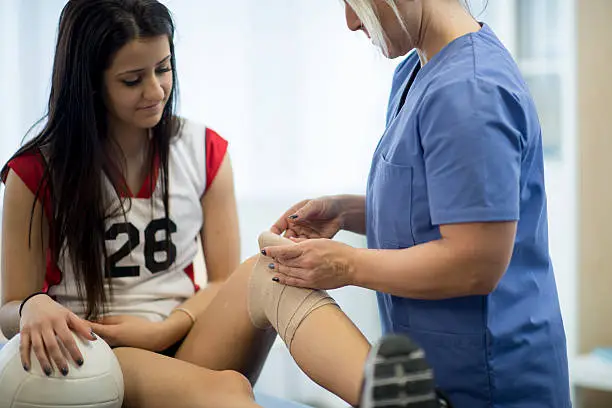When passion for sports meets physical limitations, injuries can occur. Understanding sports injuries – their types, causes, symptoms, and treatments – is crucial for athletes at all levels, from weekend warriors to professional competitors.
Understanding Sports Injuries
Sports injuries typically fall into two categories: acute injuries that happen suddenly during activity, and chronic injuries that develop over time due to repetitive training. Both types can significantly impact an athlete’s performance and require proper attention for optimal recovery.
Common Types of Sports Injuries
Sprains and Strains
Sprains occur when ligaments (the tough bands connecting bones) stretch or tear. Ankle sprains are particularly common in sports involving quick directional changes. Symptoms include:
- Immediate pain
- Swelling around the joint
- Limited mobility
- Possible bruising
- Tenderness to touch
Knee Injuries
The knee, being one of the most complex joints in the body, is particularly vulnerable to injury. Common knee injuries include:
- ACL Tears
- Often occurs during sudden stops or direction changes
- Accompanied by a “popping” sound
- Immediate swelling
- Instability when walking
- Meniscus Tears
- Results from twisting movements
- Gradual swelling
- Pain when rotating the knee
- Difficulty fully straightening the leg
Shoulder Injuries
Athletes involved in overhead sports like baseball or swimming frequently experience shoulder problems:
- Rotator Cuff Injuries
- Pain during specific movements
- Weakness in the shoulder
- Difficulty sleeping on the affected side
- Limited range of motion
- Shoulder Dislocation
- Visible deformity
- Intense pain
- Inability to move the joint
- Swelling and bruising
Muscle Injuries
Muscle injuries range from mild strains to complete tears:
- Muscle Strains
- Sudden sharp pain
- Muscle weakness
- Limited flexibility
- Possible bruising
- Muscle Contusions
- Direct impact injury
- Immediate pain and swelling
- Restricted movement
- Visible bruising
Common Causes of Sports Injuries
Understanding the causes helps in prevention:
Training Errors
- Rapid increase in training intensity
- Inadequate rest between sessions
- Poor technique
- Improper equipment use
Environmental Factors
- Unsafe playing conditions
- Extreme weather
- Inadequate equipment
- Poor field maintenance
Physical Factors
- Muscle imbalances
- Previous injuries
- Poor flexibility
- Inadequate conditioning
Treatment Approaches
Immediate Care (RICE Protocol)
The RICE method remains a cornerstone of initial injury treatment:
- Rest: Avoid using the injured area
- Ice: Apply cold therapy for 15-20 minutes every 2-3 hours
- Compression: Use elastic bandages to reduce swelling
- Elevation: Keep the injured area above heart level
Professional Medical Care
Depending on severity, professional treatment may include:
- Physical therapy
- Surgery for severe cases
- Pain management
- Rehabilitation programs
Rehabilitation Process
A proper rehabilitation program typically involves:
- Initial Recovery Phase
- Pain management
- Inflammation control
- Protection of injured area
- Intermediate Phase
- Gentle exercises
- Range of motion work
- Strength building
- Advanced Recovery
- Sport-specific training
- Return to activity planning
- Prevention strategies
Prevention Strategies
Proper Training
- Gradual intensity increases
- Adequate warm-up and cool-down
- Proper technique instruction
- Regular rest periods
Equipment and Environment
- Using appropriate protective gear
- Properly fitted equipment
- Safe playing conditions
- Regular equipment maintenance
Physical Preparation
- Regular flexibility work
- Strength training
- Balance exercises
- Proper nutrition and hydration
Long-term Considerations
Return to Sport
The decision to return to sport should consider:
- Full range of motion restoration
- Adequate strength recovery
- Sport-specific skill demonstration
- Mental readiness
Future Injury Prevention
Ongoing prevention strategies include:
- Regular screening for risk factors
- Maintenance exercises
- Proper technique reinforcement
- Regular rest and recovery
When to Seek Medical Attention
Immediate medical attention is necessary if:
- Severe pain or swelling occurs
- Joints appear deformed
- Weight-bearing is impossible
- Loss of sensation is present
- Significant weakness exists
Conclusion
Sports injuries, while common, don’t have to be career-ending. Understanding the types, causes, and proper treatment approaches helps athletes make informed decisions about their health and recovery. Prevention remains the best strategy, but when injuries occur, proper care and rehabilitation are crucial for a safe return to sport.
Remember, each injury is unique, and treatment should be tailored to individual circumstances. Always consult healthcare professionals for proper diagnosis and treatment plans.
Additional Resources
For more information, consider consulting:
- Sports medicine specialists
- Physical therapists
- Athletic trainers
- Sports-specific coaches
The road to recovery from sports injuries requires patience, dedication, and proper guidance. With the right approach to prevention and treatment, athletes can minimize their risk and optimize their performance when returning to their chosen sport.



